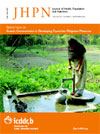
|
The Journal of Health, Population and Nutrition
icddr,b
ISSN: 1606-0997
EISSN: 1606-0997
Vol. 29, No. 4, 2011, pp. 400-405
|
 Bioline Code: hn11050
Bioline Code: hn11050
Full paper language: English
Document type: Research Article
Document available free of charge
|
|
|
The Journal of Health, Population and Nutrition, Vol. 29, No. 4, 2011, pp. 400-405
| en |
Measurement of and Trends in Unintended Birth in Bangladesh, 1983-2000
Gipson, Jessica D.; Hossain, Mian Bazle & Koenig, Michael A.
Abstract
Bangladesh has experienced a rapid decline in fertility in the past several decades, facilitated by proactive population policies, provision of contraceptives, and broader societal shifts, encouraging smaller families and use of contraceptive to achieve revised childbearing norms. This paper presents 18 years of data from the Sample Registration System, a demographic surveillance system operated by the Maternal and Child Health-Family Planning Extension Project in six study areas in Bangladesh. Prospective measurements of women’s fertility preferences were used for classifying nearly 25,000 birth outcomes from 1983 to 2000 as intended, unintended, or ‘up to God/Allah’. Over the 18-year period, the level of unintended births varied from 22% to 38%, with the lowest levels in the mid-1990s. Fatalistic responses declined significantly from 25% in the mid-1980s to 1% by the late 1990s. Results of the comparison of two geographic areas of Bangladesh indicate differential declines in the levels of unintended pregnancies over the study period. Prospective measurements of unintended pregnancies were 2-3 times the magnitude indicated by retrospective estimates of unwanted births from the demographic and health surveys conducted during the study period. This unique dataset provides a rare opportunity to visualize the vast changes in fertility preferences and unintended births in Bangladesh from 1983 to 2000. Significant declines in fatalistic responses reflect broader social changes that occurred in Bangladesh to facilitate the fertility decline and contraceptive uptake. The drastic differences between prospective and retrospective measurements of fertility preferences highlight the importance of considering the strengths and limitations of each method when attempting to estimate the true level of unintended pregnancies and births in a population.
Keywords
Demographic transition; Fertility; Fertility decline; Bangladesh
|
| |
© Copyright 2011 Journal of Health Population and Nutrition.
Alternative site location: http://www.jhpn.net
|
|
